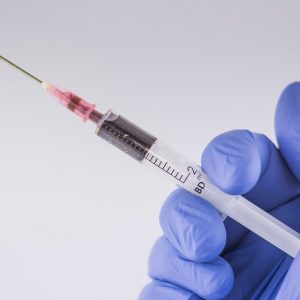
Alopecia areata, a condition where a person’s own immune system attacks their hair follicles, can sometimes be difficult to treat. That’s because the treatment options that we have traditionally relied on are unfortunately not effective for everyone1. Those that are unresponsive to therapy may develop bald patches which could progressively worsen with the potential to lose all hair, including body hair. Moreover the disease progression is somewhat unpredictable as it’s also possible for any lost hair to regrow spontaneously, with no treatment necessary2. Fortunately for those who do wish to move forward with therapy, new research has led to some innovative medications, devices and procedures which may encourage hair growth.
One potential new option is platelet-rich plasma (PRP) therapy. PRP has become widely used in medicine, with its advantages demonstrated in dentistry3, orthopedic surgery4, aesthetics and skin rejuvenation5 as well as sports medicine. It is a procedure where no medication is required. A small amount of blood is removed from the arm. Platelets are then collected from the blood. A concentrated dose (approximately three to seven times the amount present in your blood) of platelets is then injected in areas of hair loss. PRP therapy is believed to encourage new hair growth by releasing a plethora of natural growth factors that were contained in the platelets6–11.
In clinical trials, 60% of patients with patchy alopecia areata achieved complete remission in under a year9. Evidence has been more variable for those with severe alopecia12 but some success has been reported13. An additional benefit to PRP treatment is that because it is your own blood being used to stimulate hair growth, experiencing side-effects is unlikely14.
Overall, if previous treatments have been unsuccessful, or you are interested in a drug-free treatment, PRP therapy may be worth investigating further. Speak with your doctor or dermatologist for more information about the procedure.
Article by: Dr. J.L. Carviel, PhD, Mediprobe Research Inc.
References
- Delamere FM, Sladden MM, Dobbins HM, Leonardi-Bee J. Interventions for alopecia areata. Cochrane Database Syst Rev. 2008;(2):CD004413.
- MacDonald Hull SP, Wood ML, Hutchinson PE, Sladden M, Messenger AG, British Association of Dermatologists. Guidelines for the management of alopecia areata. Br J Dermatol. 2003 Oct;149(4):692–9.
- Watt-Smith S. Dental and craniofacial applications of platelet-rich plasma. Br Dent J. 2005 Dec 24;199(12):799–799.
- Lin SS, Montemurro NJ, Krell ES. Orthobiologics in Foot and Ankle Surgery. J Am Acad Orthop Surg. 2016 Feb;24(2):113–22.
- Bhanot S, Alex JC. Current applications of platelet gels in facial plastic surgery. Facial Plast Surg FPS. 2002 Feb;18(1):27–33.
- Tomita Y, Akiyama M, Shimizu H. PDGF isoforms induce and maintain anagen phase of murine hair follicles. J Dermatol Sci. 2006 Aug;43(2):105–15.
- Takakura N, Yoshida H, Kunisada T, Nishikawa S, Nishikawa SI. Involvement of platelet-derived growth factor receptor-alpha in hair canal formation. J Invest Dermatol. 1996 Nov;107(5):770–7.
- Li ZJ, Choi H-I, Choi D-K, Sohn K-C, Im M, Seo Y-J, et al. Autologous platelet-rich plasma: a potential therapeutic tool for promoting hair growth. Dermatol Surg Off Publ Am Soc Dermatol Surg Al. 2012 Jul;38(7 Pt 1):1040–6.
- Trink A, Sorbellini E, Bezzola P, Rodella L, Rezzani R, Ramot Y, et al. A randomized, double-blind, placebo- and active-controlled, half-head study to evaluate the effects of platelet-rich plasma on alopecia areata. Br J Dermatol. 2013 Sep;169(3):690–4.
- Sohn K-C, Shi G, Jang S, Choi D-K, Lee Y, Yoon T-J, et al. Pitx2, a beta-catenin-regulated transcription factor, regulates the differentiation of outer root sheath cells cultured in vitro. J Dermatol Sci. 2009 Apr;54(1):6–11.
- Marx RE. Platelet-rich plasma: evidence to support its use. J Oral Maxillofac Surg Off J Am Assoc Oral Maxillofac Surg. 2004 Apr;62(4):489–96.
- Ovidio R d’. Limited Effectiveness of Platelet-Rich-Plasma Treatment on Chronic Severe Alopecia Areata. Hair Ther Transplant [Internet]. 2014 [cited 2016 Feb 18];04(01). Available from: http://www.omicsgroup.org/journals/limited-effectiveness-of-plateletrichplasma-treatment-on-chronic-severe-alopecia-areata-2167-0951.1000116.php?aid=24661
- Singh S. Role of platelet-rich plasma in chronic alopecia areata: Our centre experience. Indian J Plast Surg Off Publ Assoc Plast Surg India. 2015 Apr;48(1):57–9.
- Gkini M-A, Kouskoukis A-E, Rigopoulos D, Kouskoukis K. Platelet-rich Plasma as a Potential Treatment for Noncicatricial Alopecias. Int J Trichology. 2015 Jun;7(2):54–63.












